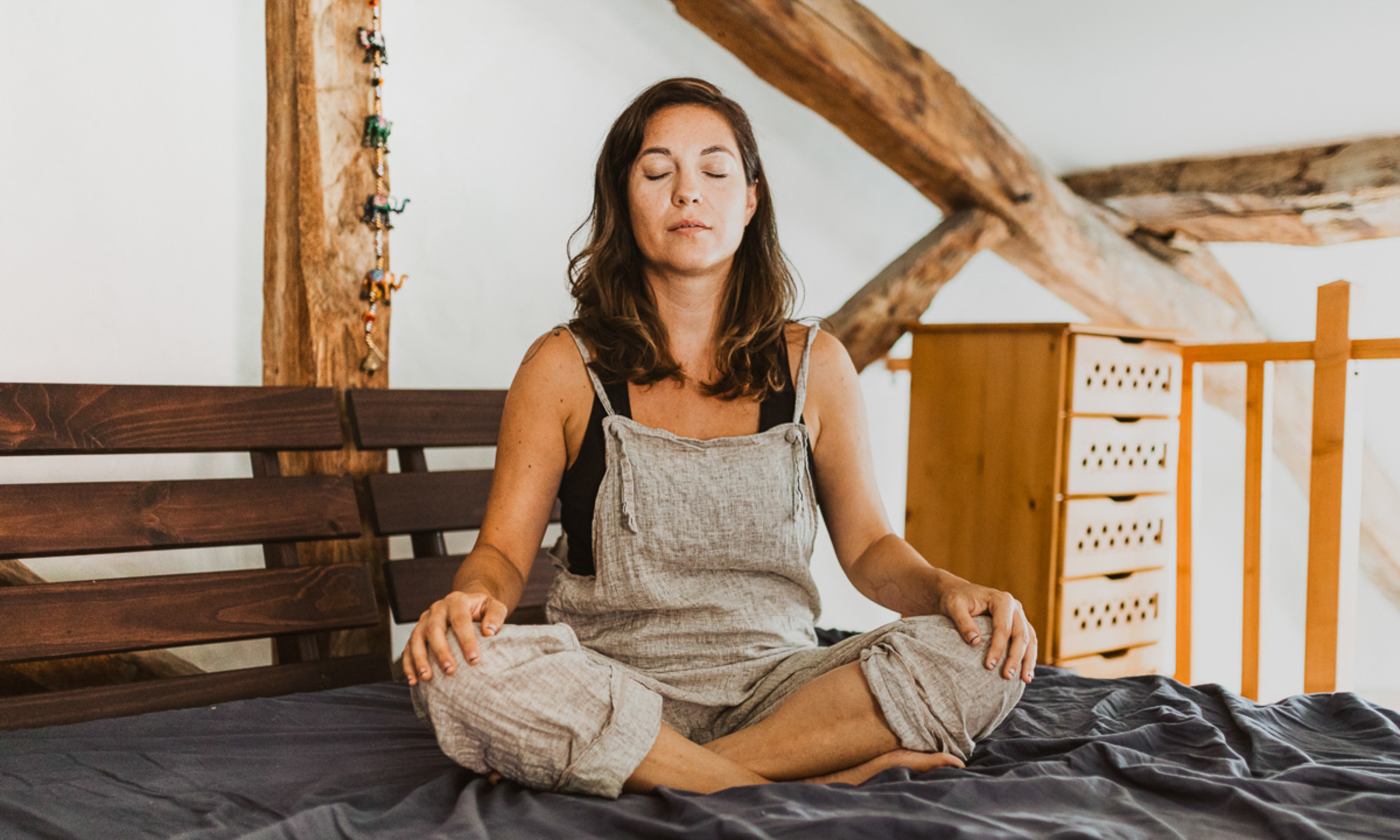Feeling Anxious? 15 Simple Ways To Calm Your Senses In 3 Minutes Or Less
For those moments when you're kinda spiraling...


Relationship Coach
Relationship Coach
Julie Nguyen is a relationship coach, Enneagram educator, and former matchmaker based in New York. She has a degree in Communication and Public Relations from Purdue University.

Expert review by
Chamin Ajjan, LCSW, A-CBT, CST
ASSECT-certified sex therapist
Chamin Ajjan, LCSW, A-CBT, CST, is a licensed clinical social worker, psychotherapist, and AASECT-certified sex therapist based in Brooklyn, NY.
Image by Isabel Alcaine / Stocksy January 27, 2023 Our editors have independently chosen the products listed on this page. If you purchase something mentioned in this article, we may When you’re in the throes of anxiety, your body sets off a series of automatic responses meant to summon your fight or flight response. Your breathing might become shallow, and your heartbeat may quicken to match your panicked thoughts. Your skin may also break out in a cold sweat, and you might tense up with fear as you ready yourself to confront the perceived threat. Experiencing anxious thoughts can be overwhelming. But using grounding techniques can help you learn how to manage your anxiety.
Advertisement
This ad is displayed using third party content and we do not control its accessibility features.
Together, let’s walk through tried-and-true ways to find stillness and try out some grounding techniques that feel restorative to your body. In the spirit of getting grounded, take a deep breath before you go through this article. Use this moment to intentionally slow down. Finding stillness in these liminal moments is just as important as choosing the calming action to take when you’re stressed. There is no need to rush. Grounding techniques are ways of calming yourself down by creating a connection to the here and now. It literally means to “ground” and anchor yourself to the concreteness of the present. Before we can talk about the value of grounding techniques, we need to understand anxiety and its role in our lives. According to marriage and family therapist Emily Maynard, LMFT, “Anxiety is an adaptive process in our nervous systems necessary for human survival. Your anxiety triggers are unique to you based on your upbringing, experiences, personality, and physicality, but often anxiety comes in a moment of risk or fear.” When anxiety becomes disordered, the frantic emotions can pull you towards upsetting flashbacks, dissociation, rumination, and distress. Although the experience can’t be eliminated altogether, it can be managed. That’s where grounding techniques come in. “Grounding techniques are exercises that help us stay in the present moment and are designed to return our bodies back to our baseline,” Ernesto Lira de la Rosa, Ph.D., a psychologist and media advisor for the Hope for Depression Research Foundation, tells mbg. By gently turning away from your worries and focusing your attention back to the present, grounding allows you to decrease the intensity of the emotion and reduce bodily stress. Anxiety happens through a cascading physiological response. A grounding technique is a natural coping strategy that tells your brain you’re safe and OK. “Just as your body knows how to activate panic, it also knows how to return to a state of calm through your parasympathetic nervous system,” de la Rosa says. Below, experts share some mindful and holistic grounding techniques to try out whenever you’re stressed, worried, or nervous. A note: While you’re working on grounding yourself, shine an empathetic light over your anxiety. As Maynard puts it, anxiety is a natural byproduct of being human, so try not to be too harsh or judge yourself for experiencing these emotions in the first place. “Anxiety is your body trying to protect you; it's just too eager, and so many of the pressures of modern life activate it. Your goal isn't to eliminate anxiety, but to live in harmony with this powerful part of your nervous system,” she says. This ad is displayed using third party content and we do not control its accessibility features.Advertisement
Physical grounding techniques:
4-7-8 breathing.
Conscious breathing can wash away unwanted stresses and balance the nervous system. It’s a useful tool to promote peace and relaxation in the body. “You start by exhaling all of your breath through your mouth,” de la Rosa advises. Then you take an inhale through your nose for 4 seconds, hold the breath for 7 seconds, and then exhale the breath through your mouth for 8 seconds. You repeat this cycle of breath at least 4 times.”
He says what makes 4-7-8 breathing (and breathing techniques like box breathing) so effective is how it can help you regulate your breathing. “It essentially helps your body feel safe and relaxed and can quell anxious thoughts,” he explains. “After doing this exercise, you will notice that your breathing patterns changed, and you may notice less tension in your body.”
Advertisement
This ad is displayed using third party content and we do not control its accessibility features.
555 breathing.
5-5-5 breathing is another breathing exercise, this one mapped out in sets of five. Breathe in and fill your lungs for five seconds. Then hold your breath for five seconds and exhale for five seconds. Repeat as often as necessary.
Tense and release the tension.
“Try tensing your hands-–like making fists-–for several seconds and then releasing the tension. You can do this with your legs, arms, feet, etc,” de la Rosa says. Clenching your fists allows you to channel the energy of the emotion in your hands, then release it.
“When you do these tense and release exercises, you are helping your body notice sensations of tension and relaxation,” de la Rosa says. “It can help distract you from some intense anxious thoughts or physiological experiences in your body.”
Advertisement
This ad is displayed using third party content and we do not control its accessibility features.
Stretch your body.
When you stretch your body, you are redirecting your attention to any tense muscles. Notice if your neck or shoulders are stiff. If they are, take a moment to relax them.
As you’re stretching your muscles, feel how your muscles contract when you activate different parts. How does it feel in the areas where you store stress, like your shoulders and neck? Take a beat to observe your muscle groups in between your tense and relaxed state. After a while, you should experience some relief from any agitating thoughts.
Change positions.
Shifting a position may sound small, but this tiny action can have a mighty effect. Maynard shares that anxiety often involves looping thoughts, so engaging in a movement can help divert your attention away from the same thinking. “Stand and stretch your arms up and let them float back down slowly. Or if you’re sitting, press your feet firmly into the floor then release. Pay attention to the subtle shift in sensations,” she says.
As you move, bring awareness to the earth beneath your feet and how the chair feels underneath your body. Paying attention to your body parts can be a reminder that the space around you is solid, unlike your thoughts which are whim to the shifting tides of your transient emotions.
Advertisement
This ad is displayed using third party content and we do not control its accessibility features.
Touch something.
Maynard recommends using objects with unique textures or weight for extra sensation. This is a somatosensory technique that can remind you of what’s really happening in the moment. You can touch anything–this can look like a knit blanket, a fuzzy pillow, a textured ball, a weighted squeeze ball, or a smooth stone. If you want to go further, you can pay attention to the colors, its weight, and how it feels in your hand.
“Pick up the item and put all your attention towards noticing the sensation of touching it,” she says. Keep your perception focused on your sensations and current surroundings.
Feel the changing temperatures.
Maynard advises using this method if you want to quickly move your attention away from anxiety. Put your hands under cold running water, touch an ice cube, drink ice water, sip a warm beverage, step outside into the cold air—whatever it is, just notice how your body responds to these new sensations.
“When you turn your attention to the physical reality rather than anxiety’s fearful predictions, you’ll feel your body calm down within a minute or two,” she explains.
The 3-3-3 method.
“The 3-3-3 rule for anxiety is simple. When you are feeling anxious, it can be helpful to name three things you see, three things you hear, and then move three parts of your body,” de la Rosa says. “When you engage in this exercise, you are bringing your attention back to the room/setting you are in and also bringing attention to your body.”
If you enjoy the exercise, look for more nuance. Can you name that particular shade of color of the object? How does the noise sound to your ears? Are your joints stiff when you stretch?
Mental grounding techniques:
Think of something else.
Maynard explains you can interrupt anxious thought spirals by simply turning your brain in another direction. Anxiety is adaptive and useful in certain situations, but when it takes up too much space, tame it by filling your mind with other things. Try not to force your perception and just bring curiosity to what’s around you. “It’s a little bit like trying to walk upstream in a rushing, anxious river at first, but just start, and it will begin to work,” she says.
One practical method to try: “Name objects you see around you, in increasing detail, like, ‘I see a chair, it’s a blue chair, it’s a blue velvet chair, it’s a blue velvet chair with brown legs and a white pillow, etc,’” Maynard explains.
Visualize a safe space.
Close your eyes and connect to your breath. Imagine your breath traveling down the base of your spine and going past your feet, like you are a tree growing roots. Visualize the roots growing with the soil underneath, and the strength of the earth. As you continue breathing, imagine your breath blooming past your head and how it feels.
When you’re doing a visualization exercise, you can imagine anything that brings you peace. Perhaps it’s a beach, forest, or bonfire. What do the waves feel like? How do the trees sound when the wind plays with the leaves? Does the bonfire smell like s’mores?
Say what you’re observing out loud.
Look at the time. What’s around you right now? What’s in the room you’re in? If you’re thinking about a past event, remembering your surroundings will steer you away from experiencing flashbacks over a past event.
It doesn’t have to be what’s around you either. If you’re stuck, get creative with your thoughts. “You can think of lists: name all the flowers you can think of, cartoons, or the names of characters in your favorite book,” Maynard suggests. She recommends saying it out loud so you can further connect to the moment instead of what’s happening in your head.
Isolate your anxiety from yourself.
Sometimes, anxiety can saturate your reality so much that you feel like it’s a part of you instead of something that you’re temporarily experiencing.
In those instances, Maynard recommends imagining your anxiety as something separate from yourself. “Draw or describe it as a little gremlin puppet, an animal, or a cartoonish ghost. Then you can mentally narrate the story of your interactions with anxiety,” she says. By externalizing your anxious behaviors, you can take back the creative control of how anxiety impacts your life.
Journal.
Journaling evokes a deeper relationship with yourself and your emotions. As a grounding technique, sitting with your reflections may help you understand that your anxious thoughts are really just thoughts that come and go–like passing trains or fluffy clouds that float away into the distance.
“You can begin to write all of the thoughts that come to your mind as a way to release those anxious thoughts. It can be helpful to read these thoughts after you finish with the exercises and remind yourself that these are anxious thoughts that are normal responses to anxiety,” de la Rosa says.
Distract yourself.
“Another mental grounding exercise can be the use of distraction,” de la Rosa says. “You can find a favorite TV show/movie to watch when you are feeling anxious. You can also listen to a favorite song(s) to help you feel different emotions. These exercises may help you find some short relief from not focusing on what you are feeling anxious or worried about.”
Use humor.
On the subject of distraction: Research has confirmed that humor is a protective factor against anxiety1. Instead of turning on your favorite sitcom, try watching a stand-up special or a funny movie to lift your spirits and take your mind off your anxious thoughts.
As you’re grounding, remember not to make any value judgments about the goodness or badness of what you’re observing. It doesn’t matter if you don’t like the pillow you’re describing or the water you’re drinking. Shift your focus to what’s in front of you; that’s all that matters. If you’re experiencing presence, then you’ve grounded yourself.
When you ground yourself, you may feel immediate effects, or it may be an incremental process. Exercise patience with what you’re experiencing. When it’s working, you’ll notice you’re not spiraling with your thoughts because you’ll feel connected to your body and immediate environment.
3.
Adapt any technique as needed to make it work for you.
The best news is that grounding doesn’t require a step-by-step protocol. As long as you are compassionately drawing your attention to the moment and connecting to your surroundings in a meaningful way, you’re grounding properly.
Preventing panic attacks or spirals
Grounding can avert your anxiety from manifesting into something more debilitating, de la Rosa says. “Using grounding techniques can help prevent anxiety from spiraling into a panic attack, by signaling to your body that it's okay for the parasympathetic nervous system to be in charge again.”
Feeling more in control
Building self-awareness in the moment is vital to your overall well-being. It helps you find control by remembering your wayward thoughts are not in charge of you–you are. “Grounding develops communication between your body and brain, so you're not lost and overwhelmed in an anxious spiral, but can build pathways back to calm,” de la Rosa says.
Feeling safe
Grounding techniques remind you of the current moment, which can bring wholeness and peace in the face of even the most tumultuous emotions. The more you learn how to be present, the more you can find safety within yourself.
Using ground techniques may help reduce your anxiety quickly, but it’s not a catchall solution. To optimize relief, maintaining a healthy lifestyle and taking care of yourself should run parallel to these coping strategies.
If you see that your anxiety is becoming more intense and beginning to interfere with your daily life, de la Rosa advises seeing a professional or therapist at that point.
“Anxiety impacts many areas of our lives and can take a toll on our well-being. Talking to a professional can provide some short-term relief, but the process of therapy is different for everyone,” he adds. “It can be helpful to know that you are working with someone who will help guide you in understanding your anxiety.”
FAQ:
How long should I ground myself daily?
As often as you need. It may take some time to find the right grounding technique, so don’t give up and keep experimenting with different coping strategies.
What is the 555 game for anxiety?
It’s a breathing exercise mapped out in “fives” for you to remember quickly. To start, you breathe in and fill your lungs with your breath for five seconds. Then hold your breath for five seconds and exhale for five seconds. Repeat as often as necessary.
It’s impossible to avoid stress–we can’t always avoid fearful situations or difficult experiences–so finding tools to bring ourselves back into the moment are key.
If you’re anxious often, Maynard recommends using grounding throughout the day. You can start small with just a few seconds and do more if you have time. What matters more is doing it as often as possible since it’s not just a one-time activity, but the beginning of a lifelong practice of being able to regulate yourself in a heart-forward way. Anxiety is a natural part of life, so it should be accepted without any shame.

 Aliver
Aliver 
































